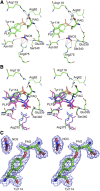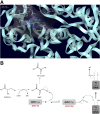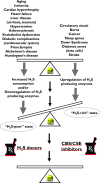International Union of Basic and Clinical Pharmacology. CII: Pharmacological Modulation of H2S Levels: H2S Donors and H2S Biosynthesis Inhibitors
- PMID: 28978633
- PMCID: PMC5629631
- DOI: 10.1124/pr.117.014050
International Union of Basic and Clinical Pharmacology. CII: Pharmacological Modulation of H2S Levels: H2S Donors and H2S Biosynthesis Inhibitors
Abstract
Over the last decade, hydrogen sulfide (H2S) has emerged as an important endogenous gasotransmitter in mammalian cells and tissues. Similar to the previously characterized gasotransmitters nitric oxide and carbon monoxide, H2S is produced by various enzymatic reactions and regulates a host of physiologic and pathophysiological processes in various cells and tissues. H2S levels are decreased in a number of conditions (e.g., diabetes mellitus, ischemia, and aging) and are increased in other states (e.g., inflammation, critical illness, and cancer). Over the last decades, multiple approaches have been identified for the therapeutic exploitation of H2S, either based on H2S donation or inhibition of H2S biosynthesis. H2S donation can be achieved through the inhalation of H2S gas and/or the parenteral or enteral administration of so-called fast-releasing H2S donors (salts of H2S such as NaHS and Na2S) or slow-releasing H2S donors (GYY4137 being the prototypical compound used in hundreds of studies in vitro and in vivo). Recent work also identifies various donors with regulated H2S release profiles, including oxidant-triggered donors, pH-dependent donors, esterase-activated donors, and organelle-targeted (e.g., mitochondrial) compounds. There are also approaches where existing, clinically approved drugs of various classes (e.g., nonsteroidal anti-inflammatories) are coupled with H2S-donating groups (the most advanced compound in clinical trials is ATB-346, an H2S-donating derivative of the non-steroidal anti-inflammatory compound naproxen). For pharmacological inhibition of H2S synthesis, there are now several small molecule compounds targeting each of the three H2S-producing enzymes cystathionine-β-synthase (CBS), cystathionine-γ-lyase, and 3-mercaptopyruvate sulfurtransferase. Although many of these compounds have their limitations (potency, selectivity), these molecules, especially in combination with genetic approaches, can be instrumental for the delineation of the biologic processes involving endogenous H2S production. Moreover, some of these compounds (e.g., cell-permeable prodrugs of the CBS inhibitor aminooxyacetate, or benserazide, a potentially repurposable CBS inhibitor) may serve as starting points for future clinical translation. The present article overviews the currently known H2S donors and H2S biosynthesis inhibitors, delineates their mode of action, and offers examples for their biologic effects and potential therapeutic utility.
Copyright © 2017 by The American Society for Pharmacology and Experimental Therapeutics.
Figures




























Similar articles
-
A Review of Hydrogen Sulfide Synthesis, Metabolism, and Measurement: Is Modulation of Hydrogen Sulfide a Novel Therapeutic for Cancer?Antioxid Redox Signal. 2019 Jul 1;31(1):1-38. doi: 10.1089/ars.2017.7058. Epub 2018 Jun 29. Antioxid Redox Signal. 2019. PMID: 29790379 Free PMC article.
-
Screening of a composite library of clinically used drugs and well-characterized pharmacological compounds for cystathionine β-synthase inhibition identifies benserazide as a drug potentially suitable for repurposing for the experimental therapy of colon cancer.Pharmacol Res. 2016 Nov;113(Pt A):18-37. doi: 10.1016/j.phrs.2016.08.016. Epub 2016 Aug 10. Pharmacol Res. 2016. PMID: 27521834 Free PMC article.
-
Physiological roles of hydrogen sulfide in mammalian cells, tissues, and organs.Physiol Rev. 2023 Jan 1;103(1):31-276. doi: 10.1152/physrev.00028.2021. Epub 2022 Apr 18. Physiol Rev. 2023. PMID: 35435014 Review.
-
Pharmacological induction of mesenchymal-epithelial transition via inhibition of H2S biosynthesis and consequent suppression of ACLY activity in colon cancer cells.Pharmacol Res. 2021 Mar;165:105393. doi: 10.1016/j.phrs.2020.105393. Epub 2021 Jan 20. Pharmacol Res. 2021. PMID: 33484818
-
Hydrogen sulfide in pharmacology and medicine--An update.Pharmacol Rep. 2015 Jun;67(3):647-58. doi: 10.1016/j.pharep.2015.01.005. Epub 2015 Jan 22. Pharmacol Rep. 2015. PMID: 25933982 Review.
Cited by
-
Sequential Accumulation of 'Driver' Pathway Mutations Induces the Upregulation of Hydrogen-Sulfide-Producing Enzymes in Human Colonic Epithelial Cell Organoids.Antioxidants (Basel). 2022 Sep 15;11(9):1823. doi: 10.3390/antiox11091823. Antioxidants (Basel). 2022. PMID: 36139896 Free PMC article.
-
Hydrogen Sulfide, an Emerging Regulator of Acid-Sensing Ion Channels.Function (Oxf). 2021 Mar 15;2(2):zqab014. doi: 10.1093/function/zqab014. eCollection 2021. Function (Oxf). 2021. PMID: 35330814 Free PMC article. No abstract available.
-
Effects of sulfane sulfur content in benzyl polysulfides on thiol-triggered H2S release and cell proliferation.Free Radic Biol Med. 2019 Feb 1;131:393-398. doi: 10.1016/j.freeradbiomed.2018.12.025. Epub 2018 Dec 21. Free Radic Biol Med. 2019. PMID: 30579781 Free PMC article.
-
H2S suppresses indoleamine 2, 3-dioxygenase 1 and exhibits immunotherapeutic efficacy in murine hepatocellular carcinoma.J Exp Clin Cancer Res. 2019 Feb 18;38(1):88. doi: 10.1186/s13046-019-1083-5. J Exp Clin Cancer Res. 2019. PMID: 30777103 Free PMC article.
-
CBS-Induced H2S Generation in Hippocampus Inhibits EA-Induced Analgesia.Evid Based Complement Alternat Med. 2020 Apr 29;2020:5917910. doi: 10.1155/2020/5917910. eCollection 2020. Evid Based Complement Alternat Med. 2020. PMID: 32419814 Free PMC article.
References
-
- Abdel-Salam E, Abdel-Meguid I, Korraa S. (2013) Assessment of immune function in Down syndrome patients. The Egyptian Journal of Medical Human Genetics 14:307–310.
-
- Abeles RH, Walsh CT. (1973) Acetylenic enzyme inactivators. Inactivation of gamma-cystathionase, in vitro and in vivo, by propargylglycine. J Am Chem Soc 95:6124–6125. - PubMed
-
- Abou-Hamdan A, Guedouari-Bounihi H, Lenoir V, Andriamihaja M, Blachier F, Bouillaud F. (2015) Oxidation of H2S in mammalian cells and mitochondria. Methods Enzymol 554:201–228. - PubMed
Publication types
MeSH terms
Substances
Grants and funding
LinkOut - more resources
Full Text Sources
Other Literature Sources
Molecular Biology Databases

